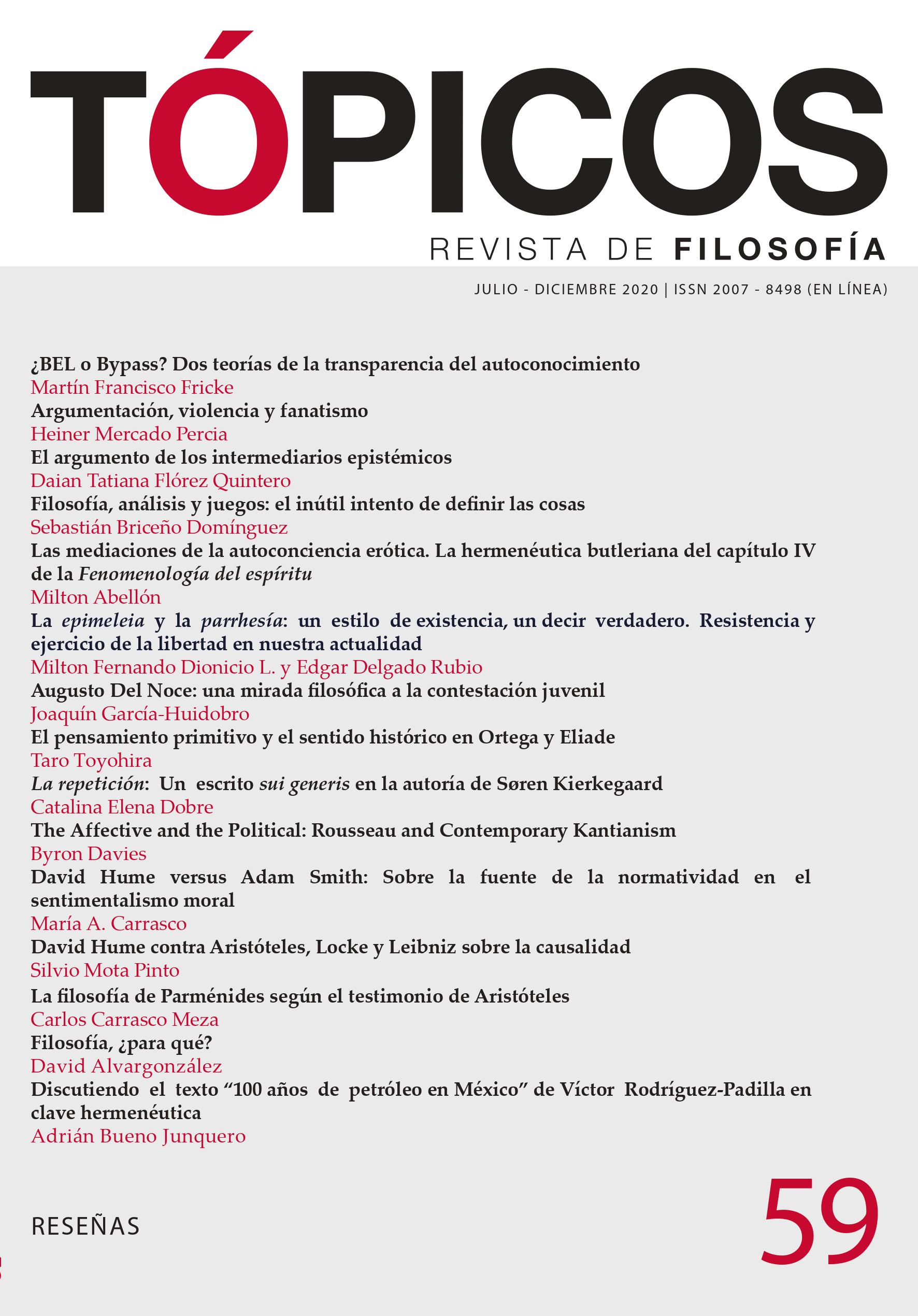Repetition: A sui generis Work in Søren Kierkegaard´s Authorship
Published 2020-06-27
Keywords
How to Cite
Downloads
Altmetrics
Citas
Abstract
Considered one of the most complex categories in Søren Kierkegaard’s thought, the repetition continues to raise much restlessness within his own authorship. Although about this category we find some first sketches in an unfinished book called Johannes Climacus or De homnibus dubitandum est, much later Kierkegaard will return to the category of repetition in his writing of the same name: Repetition, a peculiar work, very difficult to understand in its own dynamics. For this reason, in this essay we propose an interpretation of the category of repetition in relation with that text, to understand why repetition is a spiritual category as Kierkegaard himself thought it, starting from the idea that for the Danish philosopher the repetition is what can
be called a “philosophy of the future”.
References
- Kierkegaard, S. (2007). Johannes Climacus o el dudar de todas las cosas. Gloria.
- Kierkegaard, S. (2007). El concepto de la angustia. Alianza.
- Kierkegaard, S. (2008). Postscriptum no científico y definitivo a Migajas filosóficas. Univ. Iberoamericana.
- Kierkegaard, S. (2008). La enfermedad mortal. Ed. Trotta.
- Kierkegaard, S. (2009). La repetición. Alianza.
- SKS: Søren Kierkegaards Skirifter.
- Caputo, J. (1987). Radical Hermeneutics. Indiana University Press.
- Cries, S. (1993). The Bilissful Security of the Momment. Recollection, Repetition and Eternal Recurrence. En Robert L. Perkins (ed.), International Kierkegaard Commentary, vol. 6. (pp. 225-246). Mercer University Press.
- Croxall, T. H. (1948). Kierkegaard Studies. Lutherworth Press.
- Eriksen, N. N. (2000). Kierkegaard´s Category of Repetition. A reconstruction. (Monograph Series, vol. 5). De Gruyter.
- Deleuze, G. (2009). Diferencia y repetición. Amorrortu.
- Dupré, L. (1985). On Time and Eternity. En Robert L. Perkins (ed.), International Kierkegaard Commentary, vol. 8. (pp. 111-131). Mercer University Press.
- Garff, J. (2017). Kierkegaard´s Muse. The Mystery of Regine Olsen. Princeton University Press.
- Hannay, A. (2010). Kierkegaard. Una biografía. Univ. Iberoamericana.
- Holm, I. W. (1991). Kierkegaard´s Repetition: A Rethorical Reading of Søren Kierkegaard´ s Concept of Repetition. Kierkegaardiana Magazine, 15.
- Lowrie, W. (1938). Kierkegaard. Oxford University Press.
- Mackey, L. (1984). Once More with Felling. Kierkegaard´s Repetition. En R. Schleifer y R. Markley (eds.), Kierkegaard and Literature: Irony, Repetition, and Criticism. University of Oklahoma Press.
- Malantschuk, G. (1971). Kierkegaard´s Thought. Princeton University Press.
- Melberg, A. (1990). Repetition in the Kierkegaardian Sense of the Term. Diacritics Magazine, The Johns Hopkins University Press. (https://www.jstor.org/stable/465332). DOI: 10.2307/465332
- Martin, H. V. (1950). Kierkegaard: The Melancholy Dane. Philosophical Library.
- Perkins, R. L. (1993). Introduction. En Robert L. Perkins (ed.), International Kierkegaard Commentary, vol. 6. (pp. 3-8). Mercer University Press.
- Shestov, L. (1938). Kierkegaard as a Religious Philosopher. Lev Shestov. URL: http://shestov.phonoarchive.org/sar/kierkegaard1.html.
- Stack, G. (1977). Kierkegaard´s Existencial Ethics. University of Alabama Press.
- Steiner, G. (1998). The Wound of Negativity: Two Kierkegaard Texts. En J. Rée y J. Chamberlain (eds.), Kierkegaard: A Critical Reader. (pp. 103-113). Blackwell.
- Stendahl, B. K. (1976). Søren Kierkegaard. Twayne Publishers.
- Tsakiri, V. (2006). Kierkegaard. Anxiety, Repetition and Contemporaneity. Palgrave Acmillian.
- Watkin, J. (1979). Kierkegaard. Dying and Eternal Life as Paradox [Tesis doctoral]. Bristol University.







